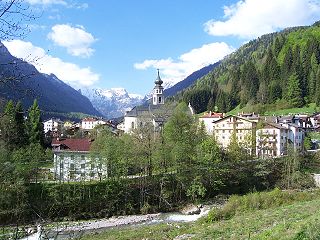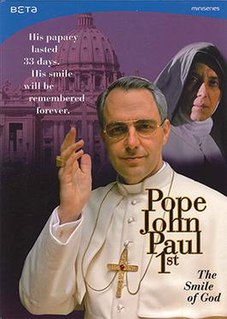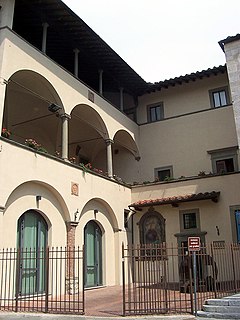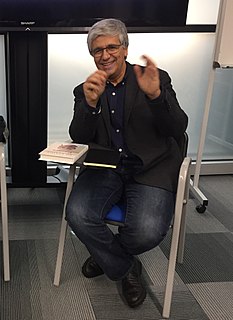
Pope John Paul I was head of the Catholic Church and sovereign of the Vatican City from 26 August 1978 to his death 33 days later. His reign is among the shortest in papal history, resulting in the most recent year of three popes and the first to occur since 1605. John Paul I remains the most recent Italian-born pope, the last in a succession of such popes that started with Clement VII in 1523.

Vittorio Veneto is a city and comune situated in the Province of Treviso, in the region of Veneto, Italy, in the northeast of Italy, between the Piave and the Livenza rivers, borders with the following municipalities:

Canale d'Agordo is a town and comune in the province of Belluno, in the region of Veneto, northern Italy. It has 1,230 inhabitants. Pope John Paul I and the landscape painter Giuseppe Zais were born in Canale d'Agordo. It has a Museum dedicated to Pope John Paul I called the Pope Luciani Museum.
Antonio De Rosso was an Italian priest and Christian leader who successively belonged to various Christian denominations. After initial priestly service in the Catholic Church, he changed several affiliations. Eventually, he became Eastern Orthodox bishop (1986), founder of the Orthodox Church in Italy (1991), Metropolitan of Ravenna and Italy (1997-2009), and Archbishop of L'Aquila (2009). He was associated with various independent (noncanonical) jurisdictions. Main goal of his religious activity was to create a national church in Italy.

Girolamo Bartolomeo Bortignon, OFM Cap was an Italian prelate of the Roman Catholic Church, serving as Bishop of Padua from 1949 to 1982.

The Diocese of Vittorio Veneto is a Roman Catholic diocese in northern Italy, with capital in Vittorio Veneto. It was historically known as Diocese of Ceneda, the name being changed in 1939.

Vittorio Umberto Antonio Maria Sgarbi is an Italian art critic, art historian, writer, politician, cultural commentator and television personality. He is President of the Museum of Modern and Contemporary Art of Trento and Rovereto. He was appointed curator of the Italian Pavilion at the 2011 Venice Biennale. Several times a member of the Italian Parliament, in 2008 he served as Cabinet Member for Culture, Arts and Sports in Milan's municipal government for six months when Mayor Letizia Moratti terminated his mandate as she saw him 'unfit for the job'. In 2012, he was removed as Mayor of Salemi by the Ministry of Interior after he failed to acknowledge Mafia interferences in his cabinet.

The Palazzo Brignole Sale or Palazzo Rosso is a house museum located in Via Garibaldi, in the historical center of Genoa, in Northwestern Italy. The palace is part of the UNESCO World Heritage Site Genoa: Le Strade Nuove and the system of the Palazzi dei Rolli. The rich art collection inside, along with the galleries of Palazzo Bianco and Palazzo Doria Tursi, is part of the Musei di Strada Nuova and consists of the works of artists of the caliber of Antoon van Dyck, Guido Reni, Paolo Veronese, Guercino, Gregorio De Ferrari, Albrecht Dürer, Bernardo Strozzi and Mattia Preti.

In the Schism of Montaner between 1967 and 1969, almost all residents of the Italian village of Montaner renounced Catholicism and embraced the Eastern Orthodox Church. This was due to a disagreement with the bishop of Vittorio Veneto, Albino Luciani, the future Pope John Paul I, over the appointment of the local priest.

The Sala delle Asse, is the location of a painting in tempera on plaster by Leonardo da Vinci, dating from about 1498. The decoration is of a room in the Castello Sforzesco in Milan. Its walls and vaulted ceiling are decorated with "intertwining plants with fruits and monochromes of roots and rocks" and a canopy created by sixteen trees.

Boncompagni Ludovisi Decorative Arts Museum, Rome, is the Decorative Arts Museum of the National Gallery of Modern Art of Rome. The Museum is located at Via Boncompagni, 18, near the elegant and historical Via Veneto.

Pope John Paul I: The Smile of God is a 2006 Italian television movie written and directed by Giorgio Capitani. The film is based on real life events of Roman Catholic Pope John Paul I.

The Diocesan museum of Brescia is a museum in Italy dedicated to the artistic patrimony of the Diocese of Brescia, and is located in the greater cloister of the Monastery of Saint Joseph in via Gasparo Salò, a short distance from the Piazza della Loggia.

The Cathedral museum of Prato, Italy was founded in 1967 in a few rooms of the Bishop's residence and in 1976 grew to include items from both the Cathedral of Saint Stephen and the diocesan territory.
The Diocesan museum of Padua displays arts and artifacts belonging to the Roman Catholic Diocese of Padua; it is housed in the 15th-century former bishop's residence or Palazzo Vescovile. The building, adjacent to the Cathedral of Padua, faces the Piazza del Duomo, can in the historic center of Padua, region of Veneto, Italy.

The Castello Roganzuolo Altarpiece, Castello Roganzuolo Polyptych or Madonna and Child with Saint Peter and Saint Paul is a painting by Titian, commissioned in 1543 by the leading citizens of Castello Roganzuolo, Province of Treviso, Veneto, Italy. It is now in the Albino Luciani Diocesan Museum in Vittorio Veneto.

Andrea Tornielli is an Italian journalist and religious writer.
Albino Lucatello was a modern Italian painter.
Roberto Montanari was an Italian painter. Known as “El Pintor de Los Toros,” he painted mostly Spanish bulls and landscapes and he was a pupil of Salvador Dalí. He held over 300 exhibitions. In 1970, 1971 and 1972 he exhibited with Pablo Picasso and Salvador Dalì.

The Visconti-Sforza Castle or Sforza Castle of Galliate is a medieval castle in Galliate, Piedmont, Northern Italy. It was erected in the 15th century by the Sforza, dukes of Milan, on a previous fortification built by their progenitors Visconti.
















